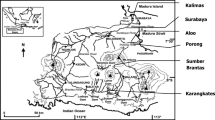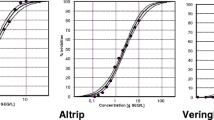Abstract
Extracts from tissues of a wide range of aquatic organisms (plants, plankton, decapods, molluscs, fish, Baikal seals, and fish-eating birds and their eggs) from Lake Baikal and from the Selenga River estuary and tissue extracts of birds breeding on Hornoya Island (northern Norway) were assayed for mutagenicity using the Ames Salmonella/microsome test. The activities of cytochrome P-450 and the enzymes of phase II of detoxification were also studied in the liver of fish and birds. Evidence was found for the accumulation of mutagens in the food chain. The relationship of bioaccumulation to the levels of enzyme activities possessing both detoxification and activation functions is discussed in the cases of fish and birds. The accumulation of mutagens was found to depend on the activity and the level of induction of the enzymes providing the detoxification and metabolic activation in the livers of fish and birds.
Similar content being viewed by others
References
Abe, A. and Urano K. (1994). Influence of chemicals commonly found in a water environment on the Salmonella mutagenicity test. Sci. Total Envir. 153, 169–175.
Ames, B.N. (1971). The detection of chemical mutagens with enteric bacteria. In A. Holaender (ed.) Chemical Mutagens: Principles and Methods for their Detection 1, pp. 267–282. New York: Plenum Press.
Ames, B.N., Lee, F.D. and Durston, W.E. (1973). An improved bacterial test system for the detection and classification of mutagens and carcinogens. Proc. Nat. Acad. Sci. USA 70, 782–786.
Ames, B.N., McCann, J. and Yamasaki, E. (1975). Method for detecting carcinogens and mutagens with the Salmonella/mammalian microsomes mutagenicity test. Mutat. Res. 31, 347–364.
Anderson, S.L. and Wild, G.C. (1994). Linking genotoxic responses and reproductive success in ecotoxicology. Environ. Health Perspect. 102(Suppl. 12), 9–12.
Baldwin, I.J. and Kramer, J.M. (1994). Biological Early Warning Systems (BEWS). In K.J.M. Kramer (ed.) Biomonitoring of Coastal Water and Estuaries, pp. 1–28. Boca Raton: CRC Press.
Bend, J.R., Miller, D.S. and Kinter, W.B. (1977). DDE induced microsomal mixed function oxidases in the puffin. Biochem. Pharmacol. 26, 1000–1001.
Bernhoft, A. and Skaare, J.U. (1994). Levels of selected individual polychlorinated biphenyls in different tissues of harbour seal (Phoca vitulina) from the southern coast of Norway. Environ. Pollut. 86, 99–107.
Black, J.J and Baumann, P.C. (1991). Carcinogens and cancers in freshwater fishes. Environ Health Perspect 90, 27–33.
Blevina, R.D., Mohr, C.D. and Pancorbo, O.C. (1987). Mutagenicity activity of fish muscle extracts. Environ. Mutagens 9(Suppl. 8), 17–19.
Brunetti, R., Gola, I. and Majone, F. (1986). Sister-chromatid exchange in developing eggs of Mytilus galloprovincialis (Bivalvia). Mutat. Res. 174, 207–211.
Bucke, D. (1993). Aquatic pollution: effects on the health of fish and shellfish. Parasitology 106, S25–37.
Chen, W., Weisburger, J.H., Fiala, E.S., Carmella, S.G., Chen, D., Spratt, T.E. and Hecht, S.S. (1995). Unexpected mutagen in fish. Nature 374, 599.
Commoner, B., Dolara, A.P., Nair, S., Madyastha, E. and Cuca, G.C. (1978). Formation of mutagens in beef and beef extract during cooking. Science 201, 913–916.
De Flora, S., Bagnasco, M. and Lanacchi, P. (1991). Genotoxic, carcinogenic and teratogenic hazards in marine environment with special reference to the Mediterranean Sea. Mutat. Res. 258, 285–320.
Felton, J.S., Healy, S., Stuermer, D., Berry, C., Timourian, H. and Hatch, F.T. (1981). Mutagens from the cooking of food, improved extraction and characterisation of mutagenic fraction from cooked ground beef. Mutat. Res. 88, 33–34.
Gornall, A.G., Bardawill, C.J. and David, M.M. (1949). Determination of serum proteins by means of the biuret reaction. J. Biol. Chem. 177, 751–766.
Grabow, W.O.K., Burger, J.S. and Hilner, C.A. (1981). Comparison of liquid extraction and resin adsorption for concentrating mutagens in Ames Salmonella / microsomal assays on water. Bull. Environ. Contam. Toxicol. 27, 442–449.
Grosheva, E.I. and Renzoni, A. (1996). Mystery PCBs distribution in the Lake Baikal biota. In M. Munovar (ed.) Proc. GLOW Symp., Zimbabwe, July 1996, pp. 11–12.
Habig, W., Pabst, M. and Jacoby, W.B. (1974). Glutathione S-transferases. First enzymic step in mercapturic acid formation. J. Biol. Chem. 249, 7130–7139.
Hess, P., de Boer, J., Cofino, W.P., Leonards, P.E.G. and Wells, D.E. (1995). Critical review of the analyses of non-and mono-ortho-chlorobiphenyls. J. Chromatog. 703, 417–465.
Hodgson, E. and Levi, P.E. (1997). Textbook of Modern Toxicology. Second Edition. Stamford: Appleton & Lange.
Ingebrigtsen, K., Skaare, J.U. and Teigen, S.W. (1984). Organochlorine residues in two Norwegian Puffin (Fratercula arctica) colonies. J. Tox. Env. Health 14, 813–828.
Isselbacher, K. J. (1956). Enzymic mechanisms of hormone metabolism. II. Mechanism of hormonal glucuronide formation. Rec. Prog. Horm. Res. 12, 134–151.
Jha A. N., Hutchinson, T.H., Mackay, J.M., Elliott, B.M. and Dixon, D.R. (1996). Development of an in vivo genotoxicity assay using the marine worm Platynereis dumerilii (Polyaecheta: Nereidae). Mut. Res. 359, 141–150.
Johannesen, K.A.M. and de Pierre, J.W. (1978). Measurement of cytochrome P-450 in the presence of large amounts of contaminating haemoglobin and methaemoglobin. Analyt. Biochem. 86, 725–732.
Knight, G.C. and Walker, C.H. (1982). A study of the hepatic microsomal monooxygenase of seabirds and its relationship to organochlorine pollutants. Comp. Biochem. Phys. C 73, 211–221.
Kotelevtsev, S.V. and Hanninen, O. (1992). Biotechnology in analysis water ecosystems: Hydrobiont tissue isoforms of cytochrome P-450. In A.I. Archakov and G.V. Bachmanova (eds.) Cytochrome P-450: Biochemistry and Biophysics, pp. 475–480. Moscow: Joint Stock Company.
Kotelevtsev, S.V. and Stepanova, L. I. (1995). Biochemical and genotoxical monitoring of ecosystems with special reference to Lake Baikal and Northern Black Sea. NATO ASI Series. Series H: Cell Biology 90, 624–666.
Kotelevtsev, S.V., Stepanova, L.I. and Glaser, V. M. (1994). Biomonitoring of genotoxicity in coastal waters. In K.J.M. Kramer (ed.) Biomonitoring of Coastal Water and Estuaries, pp. 205–227. Boca Raton: CRC Press.
Lebedev, A.T., Poliakova, O.V., Karakhanova, N.K., Petrosyan, V.S. and Renzoni, A. (1998). The contamination of birds with organic pollutants in the Lake Baikal region. Sci. Total Environ. 212, 153–162.
Lindstrom-Seppa, P. and Oikari, A. (1990). Biotransformation and other toxicological and physiological responses in rainbow trout (Salmo gairdneri) caged in lake receiving effluents of (from) pulp and paper industry. Aquat. Toxicol. 16, 187–204.
Marsh, S., Chipman, J.K. and Livingstone, D. (1991). Activation of carcinogens to mutagenic products by the mussel Mytilus edulis. Mutat. Res. 252, 191.
Moore, M.S., Smolowitz, R. and Stegeman, J.J. (1989). Cellular alterations preceding neoplasia in Pseudopleuronectes americanus from Boston Harbor. Mar. Environ. Res. 28, 425–429.
Murchelano R.A. (1990). Fish health and environmental health. Environ Health Perspect 86, 257–266.
Nakata, H., Tanabe, S., Tatsukawa, R., Amano, M., Miyazaki, N. and Petrov, E.A. (1995). Persistent organochlorine residues and their accumulation kinetics in Baikal seal (Phoca sibirica) from Lake Baikal, Russia. Environ. Sci. Technolol. 29, 2877–2885.
Nakata, H., Tanabe, S., Tatsukawa, R., Amano, M., Miyazaki, N. and Petrov, E.A. (1997). Bioaccumulation profiles of polychlorinated biphenyls including coplanar congeners and possible toxicological implications in Baikal seal (Phoca sibirica). Environ. Pollut. 95, 57–65.
Nakata, H., Tanabe, S., Tatsukawa, R., Koyama, Y., Miyazaki, N. Belikov, S. and Boltunov, A. (1998). Persistent organochlorine contaminants in ringed seals (Phoca hispida) from the Kara Sea, Russian Arctic. Environ. Toxicol. Chem. 9, 1745–1755.
Oguri, A., Karakama, K., Arakawa, N., Sugimura, T., Wakabayashi, K. (1995). Detection of mutagenicity of diphenyl ether herbicides in Salmonella typhimurium YG1026 and YG1021. Mutat Res. 346, 57–60.
Payne, J.F., Fancey, L.L., Rahimtula, A.D. and Porter, E.L. (1987). Review and perspective on the use of mixed-function oxygenase enzymes in biological monitoring. Comp. Biochem. Phys. C 86, 233–245.
Peakall, DB. and Shugart, L.R. (1993). Biomarkers: Research and Application in the Assessment of Environmental Health. Heidelberg: Springer-Verlag.
Prough, R.A., Burke, M.D. and Mayer, R.T. (1978). Direct fluorimetric methods for measuring mixed-function oxidase activity. Method Enzymol. 52C, 372–377.
Quillardet, P. and Hofnung, M. (1993). The SOS chromotest—A review. Mutat. Res. 297, 235–279.
Quillardet, P., Huisman, O., Dari, R. and Hofnung, M. (1982). SOS chromotest, a direct assay of induction of an SOS function in Escherichia coli K-12 to measure genotoxicity. Proc. Nat. Acad. Sci. USA 79, 5971–5975.
Roy, S. and Hanninen, O. (1994). Biochemical monitoring of the Aquatic Environment: Possibilities and Limitations. In M. Richardson (ed). Ecotoxicology monitoring, pp. 119–135. New York: VCH.
Shugart, L.R. (1995). Environmental genotoxicology. In G.M. Rand (ed). Fundamentals of Aquatic Toxicology, pp. 405–419. Bristol: Taylor & Francis Publishers.
Tephly, T.R. and Burchll, B. (1990). UDP-glucuronosyl transferases: a family of detoxication enzymes. Trends Pharmacol. Sci. 11, 276–279.
Ullrich, V. and Weber, P. (1972). O-deethylation of 7-ethoxycoumarin by liver microsomes. Z. Phys. Chem. 353, 1171–1177.
Vian, C.J., Sherman, S.M. and Sabharwal, P.S. (1982). Comparative extraction of genotoxic components of air particulates with several solvent systems. Mutat. Res. 105, 133–137.
Walker, C.H. (1980). Species variations in some hepatic microsomal drug-metabolising enzymes. Prog. Drug Metabolism 5, 113–164.
Walker, C.H. (1987). Kinetic models for predicting bioaccumulation of pollutants in ecosystems. Environ. Pollut. 44, 227–240.
Walker, C.H. (1990). Persistent pollutants in fish-eating seabirds—bioaccumulation, metabolism and effects. Aquat. Toxicol. 17, 293–324.
Wirgin, I. and Waldman, J.R (1998). Altered gene expression and genetic damage in North American fish populations. Mutat. Res. 399, 193–219.
Author information
Authors and Affiliations
Corresponding author
Rights and permissions
About this article
Cite this article
Stepanova, L.I., Glaser, V.M., Savinova, T.I. et al. Accumulation of Mutagenic Xenobiotics in Fresh Water (Lake Baikal) and Marine (Hornoya Island) Ecosystems. Ecotoxicology 8, 83–96 (1999). https://doi.org/10.1023/A:1008962601914
Issue Date:
DOI: https://doi.org/10.1023/A:1008962601914




